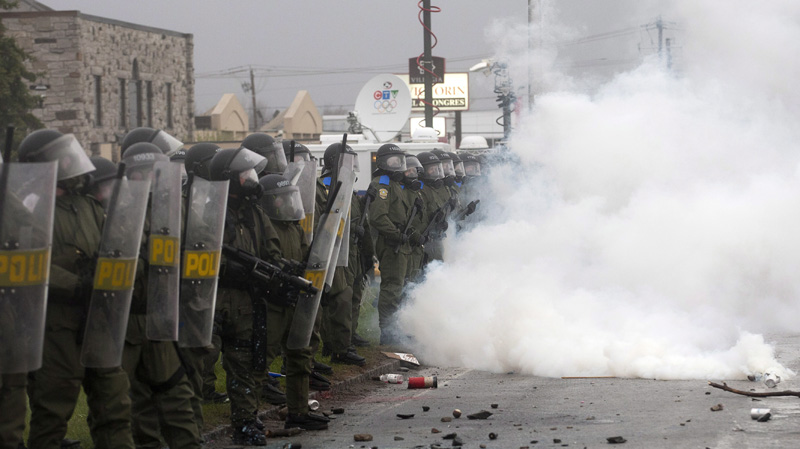Police use tear gas, smoke bombs after Molotov cocktails reportedly tossed
By Monique Muise, The Gazette May 19, 2012
Tuition-hike protesters continue to march the streets of Montreal on Friday, May 18, 2012.
Photograph by: Tijana Martin , The Gazette
MONTREAL - Appeals for calm from various student associations and political leaders following the passage of a controversial new law in Quebec appeared to be largely heeded as several thousand people protested peacefully in Montreal from Friday night until 3:30 a.m. Saturday.
About two hours into the event, however, police reported a series of Molotov cocktails had been thrown at officers by a handful of protesters, prompting the riot squad to deploy smoke bombs, percussion bombs and CS gas against the entire crowd.
Until that point, Friday's demonstrators had followed a sequence of events that has become familiar to police, event organizers and the average Montrealer over the last three months; leaving Parc Émilie-Gamelin around 9 p.m. and winding their way slowly toward the downtown core. As usual, police followed closely and adjusted as the march changed course several times; at one point stopping in front of the Montreal courthouse and completely reversing direction.
Also as per usual, a small group of violent protesters attempted to cause mayhem, getting into scuffles with police shortly after the event began. But for the most part, all seemed to be unfolding peacefully.
The police response just before 10 p.m. came fast and furious, however, allegedly in response to attacks by a small group of violent demonstrators near the entrance to Montreal's Chinatown along René-Lévesque Blvd. The huge crowd immediately scattered in panic, then regrouped and kept marching peacefully en masse, chanting, "We stay together!"
While police declared the gathering illegal, they still had not intervened again as of midnight. The crowd continued to walk, splitting into smaller groups that eventaully met up again. There were scattered reports of broken windows and at least one altercation involving a bystander. Four arrests were made: two for armed aggression related to the Molotov cocktails, one for assault on an officer and one for being nude in public. Report reported that the window of a Bank of Montreal was broken and the building itself vandalized.
There was a palpable undercurrent of anger rippling through the crowd throughout the evening, likely stemming from the passage just hours before of new provincial legislation that will have a direct impact on public protests in Quebec.
The law, Bill 78, which passed in the National Assembly at 5:30 p.m. and came into effect hours later with the signature of the province’s Lieutenant Governor, stipulates that protest organizers must disclose the start time, end time and route of their planned demonstration to police eight hours before the event begins. Montreal police said they were provided with that information Friday night. Near midnight, however, the police tweeted, via @SPVM, that "Bill 78 can't be enforced this evening, because the #SPVM has to ensure the modalities of application before."
Many of those who came out for the event said they want to see the law scrapped entirely.
"I read the law, and it doesn't make sense," said high school student Laurence Simard, 16, before the march began. "The government is just closed off to the demands of students."
Her friend, Oliver Cohen, 15, said he wasn't too concerned about possible violence during the event, but added that "people are angry. And they have the right to be angry."
Friday night’s demonstration also came on the heels of the passage a controversial new municipal regulation. A bylaw adopted by Montreal city council early in the day made it illegal to wear a mask, scarf or hood during a public demonstration in the city without a valid excuse, or hold that demonstration without first providing police with a route.
Those rules are expected to come into force on Saturday morning.
Read more: http://www.montrealgazette.com/news/Police+tear+smoke+bombs+after+Molotov+cocktails+reportedly+tossed/6647402/story.html#ixzz1vOlYIrJd



